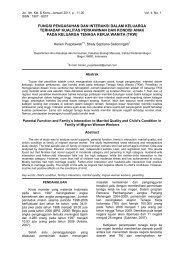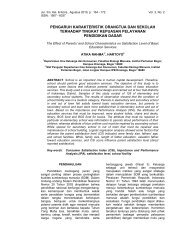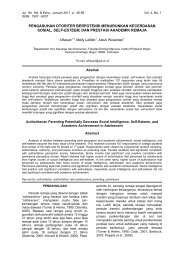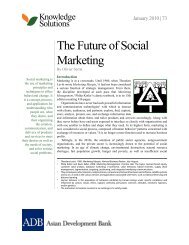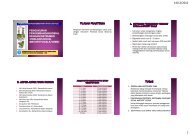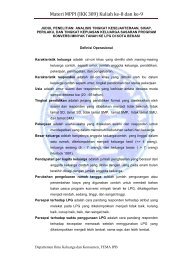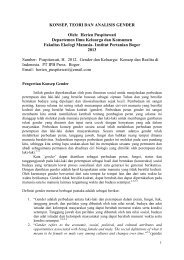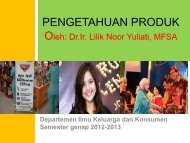SOCIAL MARKETING TO ELIMINATE LEPROSY IN SRI LANKA
SOCIAL MARKETING TO ELIMINATE LEPROSY IN SRI LANKA
SOCIAL MARKETING TO ELIMINATE LEPROSY IN SRI LANKA
Create successful ePaper yourself
Turn your PDF publications into a flip-book with our unique Google optimized e-Paper software.
Social Marketing Quarterly /Summer 1998 <strong>IN</strong>T'L <strong>SOCIAL</strong> <strong>MARKET<strong>IN</strong>G</strong> 27<br />
<strong>SOCIAL</strong> <strong>MARKET<strong>IN</strong>G</strong><br />
<strong>TO</strong> <strong>ELIM<strong>IN</strong>ATE</strong> <strong>LEPROSY</strong><br />
<strong>IN</strong> <strong>SRI</strong> <strong>LANKA</strong><br />
By Penny Grewal Williams, Dayamal Dewapura,<br />
Padmini Gunawardene and Sunil Settinayake<br />
This paper discusses the interim report on an ongoing social marketing program<br />
started in 1990 to eliminate leprosy from Sri Lanka by the local Health Ministry<br />
and the Novartis Foundation for Sustainable Development.<br />
Downloaded by [FHI 360], [Michael Williams] at 13:23 15 September 2011<br />
Background<br />
T eprosy is a chronic infectious disease which, if untreated, can lead to permanent<br />
J—fand progressive nerve damage and thereby to deformities of the limbs, eyes and<br />
face. It has traditionally been characterized by extreme social stigma leading to the<br />
marginalization of sufferers. The clinical signs of leprosy include insensitive skin<br />
lesions and thickened peripheral nerves. Untreated infectious leprosy cases are the<br />
primary source of infection and transmit the disease through nasal secretions. Persons<br />
with low cell-mediated immunity are at risk of developing clinically active leprosy<br />
irrespective of gender, age or social class.<br />
Many communities still discriminate against leprosy sufferers and consider the<br />
disease to be contagious, mutilating and incurable despite tremendous improvement in<br />
its treatment. Since 1982, the World Health Organization (WHO) recommends multiple<br />
drug therapy (MDT) for the treatment of leprosy as it cures the disease within a year,<br />
interrupts its transmission, and helps prevent deformities through early cure.<br />
At the 44th World Health Assembly in 1991, a resolution to eliminate leprosy<br />
as a public health problem by the year 2000 was adopted. Elimination was defined as<br />
attaining a prevalence of less than 1 case per 10,000 population. According to WHO,<br />
leprosy is currently a public health problem in 55 countries and over one-fifth of the<br />
estimated 1.15 million leprosy cases in the world remain undetected.<br />
Sri Lanka, a country with an exemplary primary health care system, was the first<br />
nation in South Asia to provide MDT to all registered leprosy patients in 1984. However,<br />
the transmission of the disease continued due to the large number of undetected cases in<br />
the community estimated at 12,000-15,000 in 1988 by the Ministry of Health. Selective<br />
screening programs to detect these cases were neither cost-effective nor efficacious: A<br />
third of the detected cases rejected the diagnosis as they associated leprosy with deformities<br />
and not the skin lesions on their body. In view of the urgent need for a dramatically<br />
different approach, the Ministry of Health and the Novartis Foundation for Sustainable<br />
Development developed an ongoing social marketing program.<br />
Theoretical Framework<br />
The behavior change required with regard to leprosy, especially among the<br />
"hidden" cases, is a high involvement decision. Such decisions are typically made<br />
through a series of stages associated with precontemplation, contemplation, action and<br />
maintenance (Prochaska & DiClemente, 1983; Andreasen, 1995).<br />
Formative research revealed poor awareness of the early signs of leprosy, even
28 <strong>IN</strong>T'L <strong>SOCIAL</strong> <strong>MARKET<strong>IN</strong>G</strong> Social Marketing Quarterly /Summer 1998<br />
among health care providers, and an irrational fear of leprosy. Many sufferers did not<br />
accept a biomédical explanation for the illness and had intense feelings of guilt and<br />
shame. The initial focus of the program was therefore on cognitive models to create<br />
awareness of the "new face" of leprosy and change values. Thereafter, efforts focus on<br />
increasing social influences (mobilizing opinion leaders), reducing perceived costs<br />
(particularly psychological costs), as well as perceived benefits (reduction of infection).<br />
The provision of quality care was important to help ensure regular attendance of clinics<br />
and compliance with treatment.<br />
The Social Marketing Program<br />
Downloaded by [FHI 360], [Michael Williams] at 13:23 15 September 2011<br />
"Product"<br />
The social marketing program was launched in 1990 in order to influence the<br />
voluntary behavior of target audiences (primarily undetected leprosy sufferers) in order<br />
to improve their personal welfare (i.e. cure of leprosy without deformities) and that of<br />
their society (i.e. to reduce the pool of infection).<br />
The key target audiences and "products" of the campaign were:<br />
• behavioral change for persons with suspicious skin lesions "seek diagnosis<br />
and treatment"<br />
• behavioral changes among health care providers "recognize leprosy and<br />
refer cases for treatment"<br />
• attitudinal and behavioral change among the general public — "leprosy is a<br />
normal disease, create a leprosy-friendly environment"<br />
The campaign hinges on a tangible product, MDT, provided free of charge to<br />
all patients by the Novartis Foundation in calendar blister packs through the leprosy<br />
control services and dermatological clinics.<br />
Promotion — Creating Demand<br />
An attractive and highly professional advertising campaign was launched to<br />
create an interest in a disease which people were, at best, indifferent to and, at worst,<br />
repulsed by. The campaign was targeted at young and middle-aged people and focused<br />
on the early signs of leprosy to enable recognition and its curability without deformities<br />
to encourage early help seeking as well as messages to dispel the stigma.<br />
Mass media, in particular TV and radio spots at prime time, as well as soap<br />
operas on TV and radio featuring leading stars, were extensively used. Newspapers,<br />
posters, hoardings, bus stickers, leaflets and other print material were used as support<br />
media. The media blitz was complemented with health educational programs for opinion<br />
leaders (e.g. priests, school teachers, villages heads) to reinforce the message<br />
through credible sources and provide the opportunity for discussions.<br />
Place — Improving Access<br />
Improving access to treatment was difficult due to personnel constraints: The<br />
leprosy team comprised three medical doctors and 15 paramedical workers and it was<br />
difficult to recruit motivated persons due to the stigma. Moreover, treatment is not<br />
available outside the leprosy campaign or the dermatological units. Therefore, in order<br />
to deal with the increase in demand for diagnosis, the entire primary health staff (over
Social Marketing Quarterly /Summer 1998 <strong>IN</strong>T'L <strong>SOCIAL</strong> <strong>MARKET<strong>IN</strong>G</strong> 29<br />
4,000 paramedical workers) and medical officers in out-patient departments of hospitals<br />
(over 1,000) were trained to suspect leprosy and refer persons with suspicious<br />
lesions to the leprosy staff. Pocket-sized calendars with the dates of the leprosy clinics<br />
in the area were distributed to all health care providers to facilitate referrals.<br />
The number of treatment points also were increased from 75 to 225, as was the<br />
frequency of selected clinics. In remote areas "events" were organized with the screening<br />
of campaign soap operas followed by dermatological clinics to treat all skin conditions.<br />
In areas with highly infectious cases, screening programs were organized to<br />
detect new cases.<br />
Price — Reducing the Costs Involved<br />
Downloaded by [FHI 360], [Michael Williams] at 13:23 15 September 2011<br />
Medical care and treatment is free for all citizens at government health centers.<br />
Better access to services by improving the network of climes have helped reduced costs<br />
for the individual (e.g. bus fare, lost wages). Patient information is provided at clinics<br />
and the social advertising campaign helped reduce psychological costs associated with<br />
leprosy.<br />
Monitoring<br />
Focus group discussions and informal interviews in public places such as bus<br />
stops were carried during the intervention to monitor the impact and modify the campaign<br />
accordingly. Regular meetings with the regional health authorities helped monitor<br />
the epidemiológica! impact and sustain political support for leprosy control.<br />
Impact of the Campaign<br />
Epidemiological<br />
impact<br />
• According to the WHO criteria, leprosy has been eliminated from Sri Lanka:<br />
The national prevalence rate before the start of the campaign in 1989 was<br />
1.4 per 10,000 inhabitants, it increased to 1.6 in 1990 and has dropped to 0.9<br />
per 10,000 inhabitants in 1996. There are still two endemic districts (out of<br />
25) with prevalence rates of over 2/10,000. The situation in the Northern and<br />
Eastern areas is uncertain due to the ongoing armed conflict.<br />
• The campaign has led to the detection and treatment of over 16,700 leprosy<br />
sufferers since its launch in 1990, over 8,700 more than the pre-campaign<br />
average of about 1,000 cases a year. As no other collateral efforts were made<br />
to detect new cases, we concluded that this was due to the social marketing<br />
campaign.
j<br />
30 <strong>IN</strong>T'L <strong>SOCIAL</strong> <strong>MARKET<strong>IN</strong>G</strong> Social Marketing Quarterly / Summer 1998<br />
New leprosy patients detected, 1984-1997<br />
Downloaded by [FHI 360], [Michael Williams] at 13:23 15 September 2011<br />
1997<br />
1996<br />
1995<br />
1994<br />
1993<br />
1992<br />
1991<br />
1990<br />
1989<br />
1988<br />
1987<br />
1986<br />
1985<br />
1984<br />
l i t<br />
••••H"" 11111 1<br />
h<br />
i<br />
F—<br />
=<br />
-<br />
••••a • ••':<br />
• ;<br />
1<br />
1 -•<br />
•••• •••• ••••<br />
•••• ••••<br />
*<br />
• •<br />
*<br />
• • y<br />
• * *"• «I * "<br />
* "* * • * '<br />
: * ' '<br />
1 • ' *<br />
. . . ) . - •<br />
-' • i '<br />
.* ' Í *<br />
- • • • ' . *<br />
. I * .<br />
: - - - • - - ' • : - / •<br />
- , . . - . .'<br />
" '<br />
.* * ' ' , i '<br />
500 1.000 1,500 2,000 2,500 3,000 3,500<br />
|IITota[ cases<br />
Attitudinal and Behavioral Impact<br />
• There has also been a dramatic increase in self reporting among newly<br />
detected cases: Approximately every second person seeks treatment on<br />
his/her initiative compared to less than one in ten in the past.<br />
• The leprosy campaign has been able to recruit additional staff due to the<br />
changed perception of the disease among health care providers.<br />
• The general health services now collaborate closely with the anti-leprosy<br />
campaign which was not the case in the past.<br />
Impact on Social and Cultural Attitudes<br />
In 1997, a study was carried out among 1,800 non-affected persons, including<br />
school teachers and midwives, as well as 430 health care providers (allopathic and<br />
ayurvedic), three years after discontinuing the social advertising campaign in order to<br />
assess its residual impact on knowledge, socio-cultural attitudes and practice. Using the
Social Marketing Quarterly /Summer 1998 <strong>IN</strong>T'L <strong>SOCIAL</strong> <strong>MARKET<strong>IN</strong>G</strong> 31<br />
Explanatory Model Interview Catalogue framework, respondents were shown photographs<br />
of representative leprosy lesions and given information about symptoms to<br />
provide a focus for questions about possible diagnosis, cause, prognosis, social attitudes<br />
and sources of information.<br />
The findings provide information on the long term impact of an intensive campaign.<br />
The paper will focus on areas with significant improvements (e.g. recognition<br />
and medical recourse, prognosis) as well as findings indicating effects that fell short of<br />
expectations.<br />
About The Authors<br />
Downloaded by [FHI 360], [Michael Williams] at 13:23 15 September 2011<br />
Penny Grewal Williams and Dayamal Dewapura are with the Novartis Foundation<br />
for Sustainable Development, Switzerland.<br />
Padmini Gunawardene and Sunil Settinayake are with the Anti-Leprosy Campaign,<br />
Ministry of Health, Sri Lanka.



